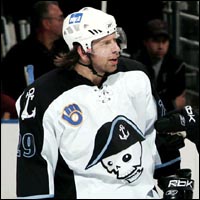by Barry Holloway || AHL On The Beat Archive
Most kids in Denmark don’t dream of growing up and playing in the NHL. Most kids in Denmark don’t dream of growing up and playing professional hockey. Like in many European nations, European football — soccer — has captured the national spotlight.
But Milwaukee Admirals forward Kim Staal and a very small handful of players from Denmark are hoping to change all of that.
The state of hockey in Denmark isn’t dire, but nor is it by any means a hockey hotbed. After the 2006 World Championships, Denmark ranked 14th out of 45 countries.
Throughout it all, Staal has become the face of Danish hockey. He has played on 17 national squads, playing in World Junior Championships, World Championships and Olympic qualifiers. When Staal started his career, hockey had yet to catch on.
“It’s a small sport. It has grown a lot over the last 10 years,” said Staal, who was only made aware of the sport because his uncle was into it.
As he grew older, Staal and his cousin would go out to the rink and play all of the time. But Staal was fortunate, as he jokingly explains, “We only have 16-18 rinks (in Denmark). That’s probably what there is in a middle town of Canada.”
Denmark’s lack of ice rinks has always hindered the chance of good hockey talent coming out of the country, but they also lack a professional league that is good enough to keep their young prospects from leaving for Sweden.
“The level is not high enough yet. You can stay home and play until you’re 20, but you have to get out.”
Staal may not be optimistic about the Danish league, where he started his career, but he has definitely seen great strides made in their national team. “They’re now much more serious. I don’t want to hang people out, but when I started the national team was different. Different things, people had jobs, and stuff like that. It’s getting more professional.”
Staal has a lot to do with that. Denmark teams he has led began building momentum around the year 2000. They made it to the last round of qualifiers for the 2002 Winter Olympics, and, more importantly, they moved up a tier in World Championship play by qualifying for the A-pool. This meant trading in weak opponents like Estonia, Slovenia and the Netherlands for the hockey powerhouses of the world: the United States, Canada, Russia and Sweden.
The 2003 World Championships would be the first time a Danish team had a chance to prove themselves in A-pool play since 1949. They lost that match in one of the most lopsided international contests in ice hockey history, at the hands of Canada. The final score in 1949 was 47-0. Staal was anxious to prove Danish hockey had changed.
“I was like 24; I was a little unsure.” Staal didn’t believe he would see the hockey elite so soon. “Maybe I would play (on the national club) 15 years without playing against the big boys first?”
But the time to play the “big boys” became a “here and now” situation and Denmark took full advantage of it. When it was all said and done they weren’t able to secure any medals, but they had come out with some big wins. Staal’s four-point game (two goals, two assists) against the American squad in the opening game helped Denmark upset the United States 5-2. They also went on to tie Canada, 2-2, the tournament’s eventual champion, which helped put their 50-year hockey woes behind them.
Despite all of Staal’s success improving his nation’s team and a decade of solid hockey played in Sweden, he still had not accomplished one of his life goals, a goal not accomplished by any other Dane before him. He wanted to play in the NHL.
So this off-season the 28-year-old Staal, a former fourth-round draft pick of the Montreal Canadiens (and no relation to current NHL Staals Eric and Jordan), packed his bags and headed to North America.
As an invitee to Nashville Predators training camp, Staal was hoping to turn his short visit to “Smashville” into an extended stay. But as his plane landed in Tennessee’s capital city he realized he wasn’t in Copenhagen anymore.
“The camp there, it was a little unreal,” Staal said with a laugh. It wasn’t long before he got his first taste of American culture. “I heard about the honky-tonks and the cowboy thing there in the country.” He smiled, “It was a pretty new experience.”
Soon enough, cowboy hats were replaced with helmets, lassos with sticks, and the business of getting a spot on a North American roster began. Yet Staal’s pre-season experience was different from everyone else. Earning a spot on Nashville’s roster would be a dream come true for many players trying to break into the league, but Staal’s addition to the roster would be a historical benchmark for all Danish players. He wasn’t just playing for himself; he was playing to legitimize a whole nation’s effort to become established in the world of ice hockey.
Despite the weight of his possible achievement, Staal doesn’t feel affected by the pressure.
“You want to do it as good as you can,” he explained. “When you go to the first day at camp, there’s [Paul] Kariya and all those guys, you think a little about it. The pressure is high for me from the inside. It’s always been. So I don’t really think about it.”
Staal’s two goals in two preseason games with the Predators was not enough to find himself on an NHL roster, but his dream was kept alive when Nashville signed him to a two-way contract and he was assigned to Milwaukee. Staal will be hoping that his time with the Admirals will lead to an opportunity to play in a league that was home to some of his favorite players.
 “Steve Yzerman, (Mario) Lemieux, and (Wayne) Gretzky.” The same names, he notes, that all other players in this age of hockey looked up to while growing up. “Then when you grow older you let it go a little bit. You want to play against them more than look at them.”
“Steve Yzerman, (Mario) Lemieux, and (Wayne) Gretzky.” The same names, he notes, that all other players in this age of hockey looked up to while growing up. “Then when you grow older you let it go a little bit. You want to play against them more than look at them.”
Staal’s assignment in Milwaukee will give him time to get settled into his new home and acquainted with a different brand of hockey. Fans of hockey are well aware of the differences in the styles played on the opposite sides of the Atlantic.
Admirals coach Claude Noel explained what Staal will have to come to expect from North American hockey: “The biggest thing all European players need to do is they need to play quicker, because there is not very much time here. There is less time to make plays because the rinks are smaller (in North America). And there’s more physical play because there is less space.”
Staal is aware of this, and in his few games with the Admirals he is already making efforts to conform to a new playing style.
“I’m working on my transitions. It’s more physical and plays a little faster on the smaller rinks. It’s different, but I think I can adjust to it quickly.”
In his three games with the Ads, Staal only has an assist. Noel believes that will likely change, “Right now I think there is an adjustment period for him in this North American style he’s been playing in Europe his whole life. He’s getting better.”
Helping him adjust to hockey in America are his Admirals teammates. As the new guy, he’s not only trying to find his niche in North American hockey, but also with his new Milwaukee teammates. Staal’s trick to finding his spot within the locker room is by watching the guys that have come before him. Guys like Admirals captain Sheldon Brookbank and Rich Peverley. Peverley played the part of “new guy” last year, and now is one of the team’s leading scorers.
He also tries to fit in by doing “humble things,” like attempting to fix the static interference on the team radio in the locker room after practice. Teammates watched as he began turning dials and adjusting antennas. Finally able to make it clear, Staal turned with a smile and began to walk back to his locker — back to static. The room had a good laugh about his unsuccessful attempt. An appointment with trainer Doug Agnew for an ice bath prevented a second one.
“I enjoy the intensity, the hard work. I enjoy the team spirit we have together on the ice and off the ice. The guys really hang together and take care of each other.” Staal jokes that his teammates have made him too acquainted with American culture, especially when it comes to language. "The language is pretty simple; maybe I learn a little too much," he laughs.
“But the guys have been good to me.”
If Staal can’t reach his dream of wearing an NHL jersey and skating on a shift in the greatest hockey league the world has to offer, there is still a lot of work to do on Denmark’s national team.
“We don’t have so many players. We have probably 17 to 20; we need 30.”
He agrees that adding more ice rinks to the Danish landscape would help this significantly, but he also knows qualifying for the Olympics is their new priority. “I maybe have one or two left. On that side of the hockey, that would be the biggest thing to achieve.”
In the twilight of his career, Staal would like to return to Denmark and play hockey. “I thought about it. It’s a long way away now. But if I stay healthy, motivated, and in the shape I’m in. I would like to finish out on my old team.”
Staal, of course, hopes to return to Danish hockey and finish his career with some NHL experience under his belt. That journey and an attempt at NHL history have begun this season in the AHL, with the Milwaukee Admirals.
Denmark has given the world Legos and the Danish pastry. One day, thanks to the efforts of Danes like Kim Staal, Denmark will hopefully be able to give something special to the world of hockey.





































